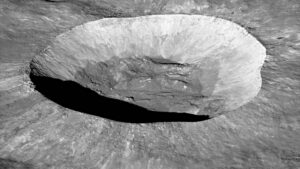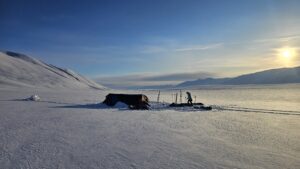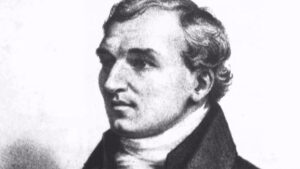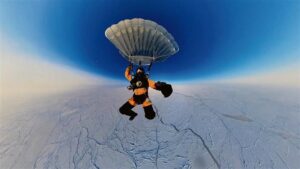While Fridtjof Nansen and Roald Amundsen sought fame and attention, Fredrik Hjalmar Johansen preferred obscurity. Yet Johansen was integral to their success. Only 80 years after his death did Johansen finally earn his place as one of Norway’s most important explorers.
Johansen’s life was turbulent. Struggling to find his place in society, he focused on sport. By the age of 18, he was a national gymnastics champion. By 21, he was a world champion in gymnastics. Preferring solo pursuits, he also excelled at skiing.
An athlete who disliked attention
Through gymnastics, he became a celebrity in Norway. But he didn’t like it. The publicity forced him into a depression. He drank excessively. But when a fresh opportunity presented itself in 1893, he took it.
Norwegian-born scientist and explorer Fridtjof Nansen had a plan to drift across the Arctic Ocean via the North Pole in a unique vessel, the walnut-shaped Fram. From the remains of another expedition that had washed up on Greenland’s shores, Nansen cleverly calculated that the drift would carry him near the still-unvisited North Pole.
Nansen had already filled all his crew positions but he saw value in Johansen’s ski experience. He offered Johansen a place on the Fram in exchange for work as a stoker and dog handler.
Johansen relished his time away from the burden of city life and found peace in the wild Arctic. To him, it was an escape.

Fridtjof Nansen.
Nansen-Johansen’s great trek
Nansen, in turn, recognized Johansen’s competence. When he realized that the Fram was going to miss the North Pole, he invited Johansen to join him in trying to ski and dogsled there. They didn’t quite reach it, but they came much closer than anyone had before. Once, Nansen saved Johansen when he fell through the ice. On another occasion, a polar bear attacked Johansen. Nansen again saved him.
Eventually, the pair retreated, using the kayaks that they kept atop their sleds to bridge the open water when they had to. After many adventures, they landed in Franz Josef Land, off the coast of Russia. Here, they spent the long winter, well-fed on an all-meat diet of polar bear, walrus, and seal.

An illustration of the hut on Franz Josef Land, where Nansen and Johansen spent the winter.
Their luck continued the following summer when Nansen miraculously bumped into the only other explorer in that region. They were saved.
Despite failing to reach the North Pole, the pair returned to a hero’s welcome. Johansen was again uncomfortable with the attention. He publicly credited Nansen with their successful return. Perhaps naive about his capabilities, he undersold his expertise.
When Johansen was in the Arctic, he flourished. So over the next two years, he participated in four Svalbard expeditions, including wintering with German explorer, Theodor Lerner.
To Antarctica
Then in 1910, on Nansen’s recommendation, he was back on the Fram. This time, he was one of Amundsen’s men heading to Antarctica. Amundsen was famously racing Englishman Robert Scott to reach the South Pole first.
Respected and ambitious, Amundsen had a firm eye on his goal. He was expected to beat Scott in the South Pole race. Amundsen was unstoppable. But Johansen’s own competence put the two at loggerheads.
When they first set off for the South Pole, Amundsen made a critical error. They began too early, still winter, and it was too cold. Some of the crew suffered frostbite. They made little progress and had to return to camp.
Amundsen showed little regard for his team. He sped back to camp with his dogsled, taking with him the cooking equipment and shelter. He wanted to stay ahead of an impending storm.
Johansen noticed an inexperienced lieutenant in trouble and came to his aid. Through the blizzard, Johansen carried his comrade 75km back to camp. He saved the lieutenant’s life.
Falling out with Amundsen
Tempers were high back at camp. Johansen argued with Amundsen, belittling a decision that might have cost lives. Scolding the proud and ruthless Amundsen in front of his men was a pivotal moment in the downward trajectory of Johansen’s career.
Johansen was demoted and assigned minor duties. Amundsen removed him from the next South Pole expedition and ordered the crew never to speak of Johansen or his accusations. Effectively, Amundsen ensured that when he penned his accounts of his eventual successful South Pole expedition, Johansen’s involvement would be omitted.
Back in civilization, unrecognized again, Johansen succumbed entirely to depression, seeking solace in alcohol. In 1913, he took a gun to his head in an Oslo park.
For almost a century, Johansen was forgotten. Amundsen enjoyed a celebrated career as an explorer and led expeditions until his disappearance in 1928. He not only reached the South Pole and traversed the Northwest Passage. Without realizing it, he was even the first to attain the North Pole, flying over it in a dirigible in 1926.
Nansen was a global superstar, not just in exploration but as a scientist and diplomat. He made early inroads into the fledgling sciences of neurology and oceanography and received the Nobel Peace Prize. Johansen received little more than a gravesite in his local cemetery.
Then in 1997, Norwegian journalist Ragnar Kvam published a biography of this forgotten man. Titled: Den tredje mann: Beretningen om Hjalmar Johansen, the book exposed Johansen’s true role in polar exploration. His legacy was finally restored.
Partly due to poor decisions and partly due to character, Johansen didn’t make a deserving mark during his lifetime. But now he has rightfully joined Norway’s great triumvirate of Nansen, Amundsen, and Sverdrup, as one of the great polar explorers.






